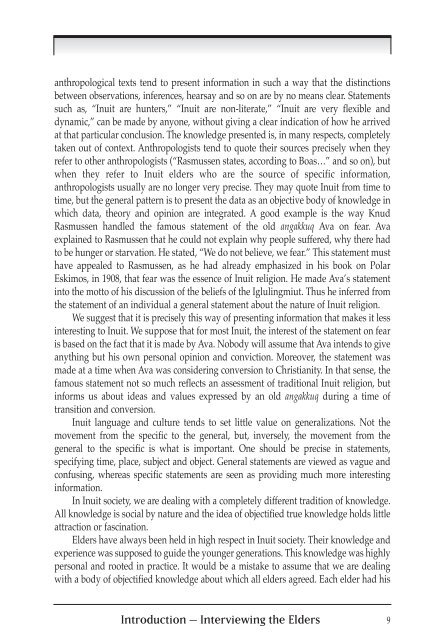Introduction-E
Introduction-E
Introduction-E
You also want an ePaper? Increase the reach of your titles
YUMPU automatically turns print PDFs into web optimized ePapers that Google loves.
anthropological texts tend to present information in such a way that the distinctions<br />
between observations, inferences, hearsay and so on are by no means clear. Statements<br />
such as, “Inuit are hunters,” “Inuit are non-literate,” “Inuit are very flexible and<br />
dynamic,” can be made by anyone, without giving a clear indication of how he arrived<br />
at that particular conclusion. The knowledge presented is, in many respects, completely<br />
taken out of context. Anthropologists tend to quote their sources precisely when they<br />
refer to other anthropologists (“Rasmussen states, according to Boas…” and so on), but<br />
when they refer to Inuit elders who are the source of specific information,<br />
anthropologists usually are no longer very precise. They may quote Inuit from time to<br />
time, but the general pattern is to present the data as an objective body of knowledge in<br />
which data, theory and opinion are integrated. A good example is the way Knud<br />
Rasmussen handled the famous statement of the old angakkuq Ava on fear. Ava<br />
explained to Rasmussen that he could not explain why people suffered, why there had<br />
to be hunger or starvation. He stated, “We do not believe, we fear.” This statement must<br />
have appealed to Rasmussen, as he had already emphasized in his book on Polar<br />
Eskimos, in 1908, that fear was the essence of Inuit religion. He made Ava’s statement<br />
into the motto of his discussion of the beliefs of the Iglulingmiut. Thus he inferred from<br />
the statement of an individual a general statement about the nature of Inuit religion.<br />
We suggest that it is precisely this way of presenting information that makes it less<br />
interesting to Inuit. We suppose that for most Inuit, the interest of the statement on fear<br />
is based on the fact that it is made by Ava. Nobody will assume that Ava intends to give<br />
anything but his own personal opinion and conviction. Moreover, the statement was<br />
made at a time when Ava was considering conversion to Christianity. In that sense, the<br />
famous statement not so much reflects an assessment of traditional Inuit religion, but<br />
informs us about ideas and values expressed by an old angakkuq during a time of<br />
transition and conversion.<br />
Inuit language and culture tends to set little value on generalizations. Not the<br />
movement from the specific to the general, but, inversely, the movement from the<br />
general to the specific is what is important. One should be precise in statements,<br />
specifying time, place, subject and object. General statements are viewed as vague and<br />
confusing, whereas specific statements are seen as providing much more interesting<br />
information.<br />
In Inuit society, we are dealing with a completely different tradition of knowledge.<br />
All knowledge is social by nature and the idea of objectified true knowledge holds little<br />
attraction or fascination.<br />
Elders have always been held in high respect in Inuit society. Their knowledge and<br />
experience was supposed to guide the younger generations. This knowledge was highly<br />
personal and rooted in practice. It would be a mistake to assume that we are dealing<br />
with a body of objectified knowledge about which all elders agreed. Each elder had his<br />
<strong>Introduction</strong> – Interviewing the Elders 9


